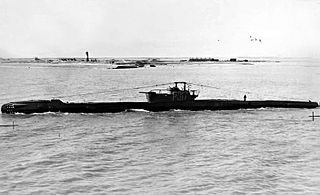
Q-ships, also known as Q-boats, decoy vessels, special service ships, or mystery ships, were heavily armed merchant ships with concealed weaponry, designed to lure submarines into making surface attacks. This gave Q-ships the chance to open fire and sink them.

USS Raton (SS/SSR/AGSS-270), a Gato-class submarine, was a ship of the United States Navy named for the raton, a polynemoid fish inhabiting semitropical waters off the Pacific coast of the Americas.

HMS Stygian was a S-class submarine of the British Royal Navy, and the only ship so far to bear the name. The boat is listed as being a member of the fourth group, although she had the external stern torpedo tube fitted as in the third group.

HMS Trenchant (P331) was a British T class submarine of the Second World War built at Chatham Dockyard.

HMS Sickle was a third-batch S-class submarine built for the Royal Navy during World War II. Completed in 1942, she made her initial war patrol off the Norwegian coast. Sickle then sailed to Gibraltar, from where she conducted one patrol, then to Algiers, French North Africa. From 10 May to 10 October, the boat patrolled the Gulf of Genoa five times and sank a German submarine as well as three minesweepers and an escort ship. She then moved to Beirut, French Lebanon, and conducted two patrols in the Aegean Sea, sinking three caïques and a merchant ship, in addition to landing resistance operatives in Greece.

HMS Sea Scout was a S-class submarine of the third batch built for the Royal Navy during World War II. She survived the war and was sold for scrap in 1965.

HMS Storm was an S-class submarine of the Royal Navy, and part of the third group built of that class. She was built by Cammell Laird and launched on 18 May 1943. So far, she is the only RN ship to bear the name Storm.

HMS Shakespeare was an S-class submarine built for the Royal Navy during the Second World War, and part of the Third Group built of that class. She was built by Vickers-Armstrongs and launched on 8 December 1941.

HMS Spirit was a S-class submarine of the third batch built for the Royal Navy during World War II. She survived the war and was scrapped in 1950.

HMS Stoic was a S-class submarine of the third batch built for the Royal Navy during World War II. She survived the war and was scrapped in 1950.
HMS Porpoise (N14) was one of the six-ship class of Grampus-class mine-laying submarines of the Royal Navy. She was built at Vickers Armstrong, Barrow and launched 30 August 1932. She served in World War II in most of the naval theatres of the war, in home waters, the Mediterranean and the Far East. She was sunk with all hands by Japanese aircraft on 19 January 1945, and was the last Royal Navy submarine to be lost to enemy action.

HMS Rorqual (N74) was a British mine-laying submarine, one of the six ships of the Grampus class of the Royal Navy. She was built by Vickers Armstrong, Barrow and launched 27 July 1936. She served in the Second World War in the Mediterranean and in the far east. She was the only Grampus-class submarine to survive the war, and she is considered the most successful minelaying submarine of World War II, sinking 57,704 GRT of enemy shipping, 35,951 of which through her mines.

HMS Truant (N68) was a T-class submarine of the Royal Navy. She was laid down by Vickers Armstrong, Barrow and launched on 5 May 1939.

HMS Tantalus was a British submarine of the third group of the T class. She was built as P318 by Vickers Armstrong, Barrow, and launched on 24 February 1943. So far she has been the only ship of the Royal Navy to bear the name Tantalus, after the mythological Tantalus, son of Zeus.

HMS Tally-Ho was a British submarine of the third group of the T class. She was built as P317 by Vickers Armstrong, Barrow and launched on 23 December 1942. She has been the only ship of the Royal Navy to bear the name, that of the hunting call, "Tally-Ho!".

HMS Templar was a British submarine of the third group of the T class. She was built by Vickers Armstrong at Barrow-in-Furness, and launched on 26 October 1942 with the pennant number P316. So far she has been the only ship of the Royal Navy to bear the name Templar, probably after the crusading order, the Knights Templar.

HMS Tantivy was a British submarine of the third group of the T class. It was built as P319 by Vickers Armstrong, Barrow, and launched on 6 April 1943. So far it has been the only ship of the Royal Navy to bear the name Tantivy.

HMS Taurus was a Second World War T-class submarine, built by Vickers Armstrong, Barrow.

HMS Manxman (M70) was an Abdiel-class minelayer of the Royal Navy. The ship is named for an inhabitant of the Isle of Man. It served in the Mediterranean during World War II, and entered the Reserve Fleet following the end of the war.



















